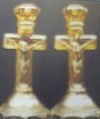Carnival Glass 101 | home Quick Reference to Carnival Glass Patterns on This Site
George W. Getts
George W. Getts
by Brian K. Pitman
Brian here in Wichita, Kansas where I just arrived and I am broadcasting a conference at the crack of dawn before heading to Boonville tomorrow night so we can broadcast the Mickey Reichel auction on Saturday morning for you at www.carnivalglasslive.com. The original intent was to broadcast both auctions (Mickey's and Wroda's) on Saturday simultaneously, but we couldn't quite get it done this weekend (but you will see it happen one weekend pretty soon!)
Of course, both auctioneers have been advertising their auctions very well (more on that in a moment), and you should have had ample chances to look at the listings online with pictures and been able to submit advance bids if you were so inclined. Advertising has indeed come a long way.
Speaking of advertising, I appreciate the many kudos I received for the BPOE article I wrote. Carnival glass marketing pieces were always a special interest to me, partly because of my marketing background and partly because in almost every single case, the piece (now) is worth more than what the sellers were trying to sell back in the day when they gave these pieces out to put their brand into the minds of the masses. Researching some of the advertisers out there uncovered many similarities among them, mostly in their aggressive styles of advertising. Take, for instance, George W. Getts.
George W. Getts was a businessman. He started his piano company in Grand Forks, North Dakota in the late 1800s (Dean and Diane Fry found evidence of his company beginning in 1889, though the formal incorporation papers weren't filed until 1906.) In addition to his store, Getts was also owned the Wagner Mill on Granite Creek near Eureka, Montana, which employed up to 30 men as part of a logging operation that began in 1920. Getts was the financial backer for the mill, while Mr. Wagner ran its daily operations. Getts was also an owner/breeder of Shorthorn Cattle, appearing in an index to owners in 1913.
Getts' pianos were made for him in Chicago and they can still be seen in the occasional second-hand sale. Presumably, business had its ups and downs, with Getts reporting in 1908 in The Music Trade Review that his business wasn't as strong as the previous year, saying "our business (volume) is fair." What Getts needed, he discovered, was marketing.
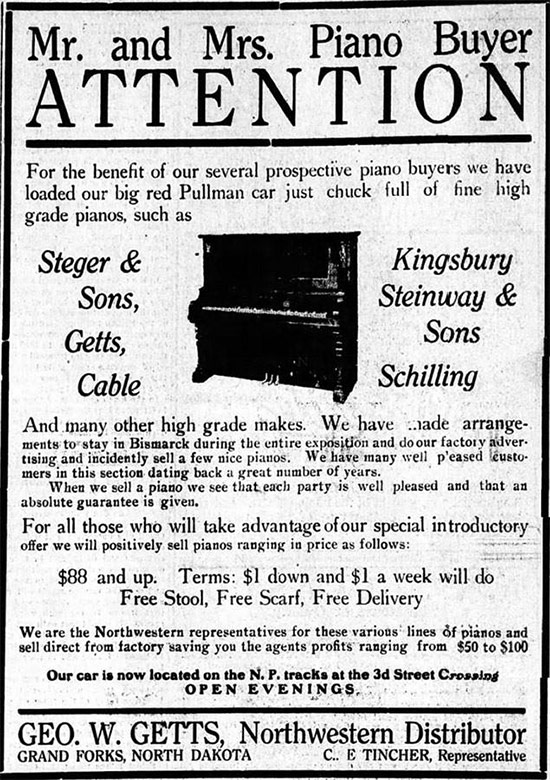
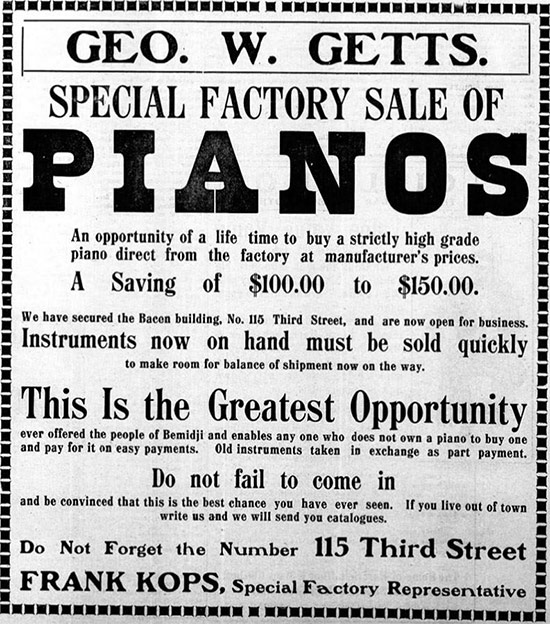
He began publishing many advertisements in local newspapers (three of them are shown here), and his advertisement announcing his opening of a store in Fargo in 1914 was called out by "The Piano Trade Magazine." Said the editorial:
"Geo. W. Getts, of Grand Forks, N. Dak., has announced his opening in Fargo with a big introductory sale, and when he uses type over three inches high he is coming pretty close to setting a record in the matter of size. Mr. Getts wanted to let people in Fargo know that he was in business and I guess he has succeeded. No one accuses him of being conservative when he says : 'Nothing but Divine Providence can prevent us from making these last days the most remarkable of any in the history of piano selling.' We believe that Mr. Getts could have obtained better results by giving a little more thought to the matter of advertising. And I don't know just what point is made by printing an illustration of an avalanche of 'was-now' cuts of pianos tumbling over a waterfall.'
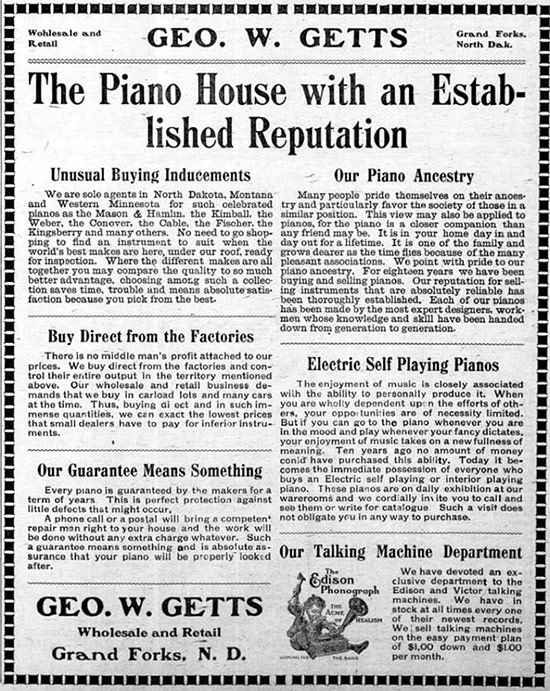
Getts also included carnival glass in his marketing plan. Using Fenton's Garden Mums blank as the template, Fenton made a series of bowls and plates for Getts, all in amethyst (with a lavender bowl known.) The bowls were ruffled and ice cream shape (ICS), and the plates included a handgrip plate. An amethyst plate and ICS bowl are pictured here. Each has the Wide Panel pattern on the back.

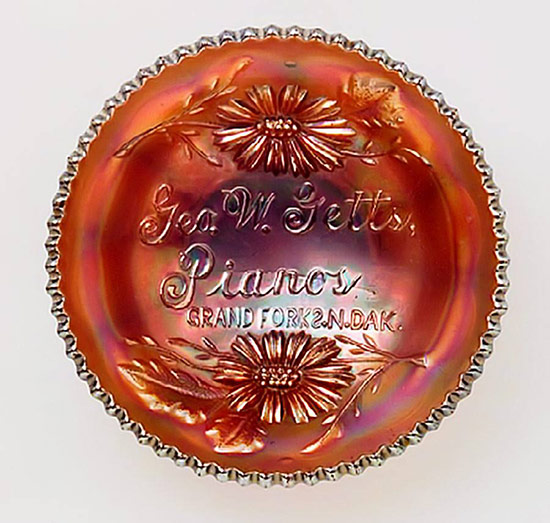
Picture of Getts bowl provided by Dave Doty.
Interestingly, the "S" in Forks is backwards (and no one knows if this is intentional or a mistake.) Speculation on the backwards S are that it was meant to look like a treble clef (to denote the musical nature of the store.)
According to the Frys, Getts died in 1923, and the Geo W. Getts Piano Store (along with Getts' aggressive marketing) died with him.
Of course, the Bernheimer Brothers in Baltimore are another interesting example of aggressive marketing. Ferdinand and Herman Bernheimer founded the Bernheimer Brothers Department Store in Baltimore in 1888. They would later add their brother Abraham to the mix. From the beginning, they were shooting for the low-end (cheap) buyer, but they employed several unconventional techniques to get them. Their store (pictured here) initially featured a rooftop garden and hosted cow milking demonstrations. The store sold groceries, clothing, and a variety of household goods (including carnival glass, which was also a product aimed at the less affluent customer, hence the nickname "Poor Man's Tiffany.") Arthur Gutman, the grand nephew of a competitor, called Bernheimers "a cheap ass store."
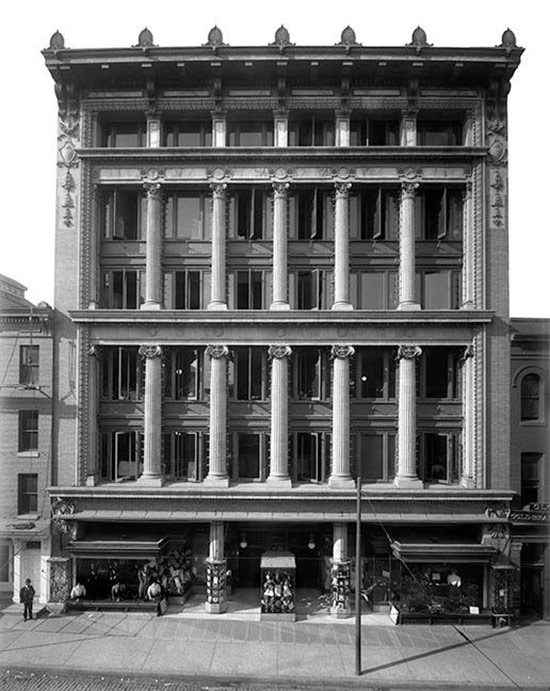
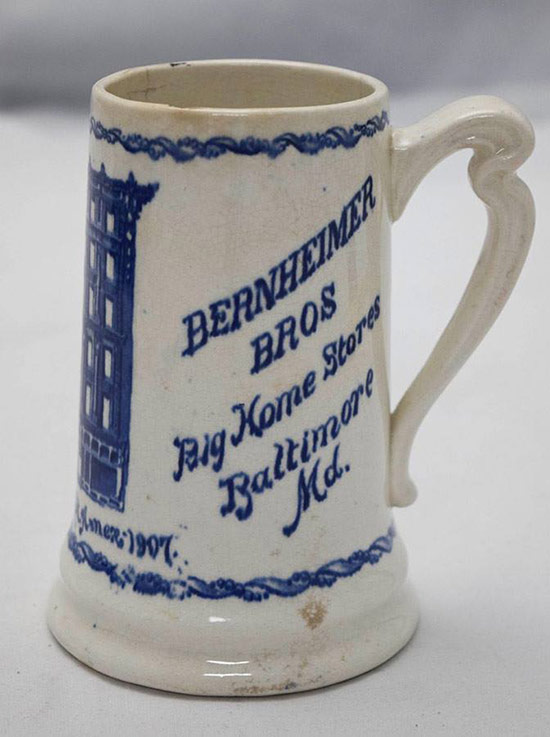
According to the Baltimore Sun, "The brothers courted shopping frenzy. They wanted their store filled with hundreds of people pawing over heaping tables of merchandise. They sought customers who would buy on impulse, regardless of whether they actually needed what they bought. People made fun of the store, but used its goods. Some snooty types would tell the Bernheimer delivery man to park his wagon (first horse-drawn, later electrically powered trucks) around the corner so the neighbors would not know the origin of the new sofa."
The Bernheimers also gave away different commemorative pieces, such as the grand opening stein (shown here), and a specially made version of the Millersburg Many Stars bowl, which we now call the Bernheimer Brothers bowl. The bowl is always in blue (a rare color for Millersburg) and features their name in the middle of the pattern. The Bernheimers bowl has a five point star, while the Many Stars has a larger six point star in the center. Both versions have the intricate Trefoil Cut pattern on the back of the bowl. We have two examples here, as well as a blue Many Stars bowl that is not a Bernheimers for comparison.
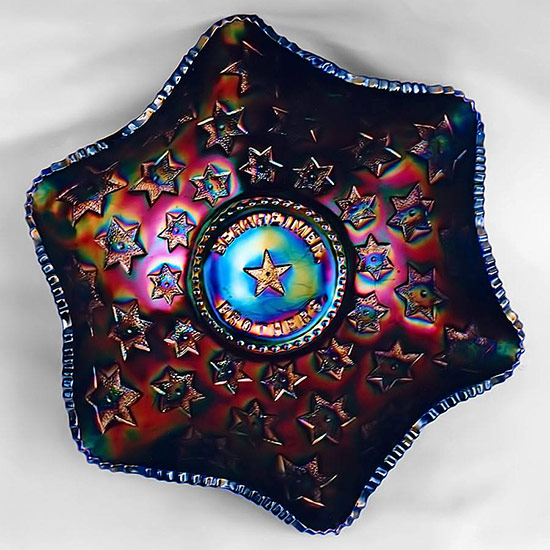

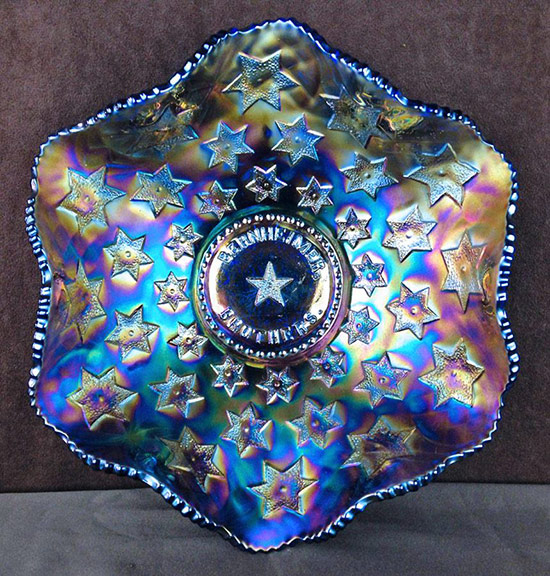
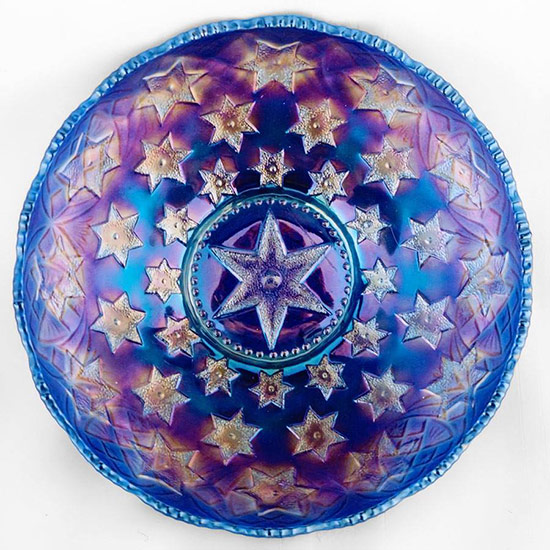
This is the Many Stars. Note the differences (bigger 6 point star, no lettering.)
Things went well for the brothers (for a time), but a series of lawsuits against them (including one for roughly strip-searching a female customer accused of shoplifting and an indictment for slaughtering an animal unfit for human consumption and selling the meat in their grocery department), their tactic of playing hardball against competitors and landlords came back to bite them. After engaging in an advertising war and price war against competitors and opening another location in a less popular part of Baltimore, they played hardball against the owner of their primary store's building (by walking out during lease extension negotiations one time too many) and they lost. The landlord signed a lease with a different client and the brothers were scrambling to stay alive. In 1923, they merged with the Leader Department Store in an attempt to go upscale, but only lasted for four years before selling out to the May Company (which still lives today, being owned by Macy's) in 1927. According to the Baltimore Sun, "When Bernheimer's went fancy, it failed. On Sept. 9, 1927, the Bernheimer flags were lowered for the last time."
Of course, the eventual demise of the company is a common theme among these companies. However, Anton Carl Dreibus was probably one of the more successful entrepreneurs among carnival glass advertisers, at least in longevity. Anton spent the first sixteen years of his life in Kreuznach, Germany. At the age of 16, he moved to the United States, ending up in Chicago working as a jobber in different industries, including Schweitzer & Beer, a company that imported alcohol, toys and fine candies. Dreibus was elected the first Financial Secretary of the Confectioners’ Agents’ Union in 1880 after establishing himself as an important person in the industry. In 1884, he moved to Omaha, Nebraska to start up Kopp, Dreibus and Co. with Michael and Jacob Kopp. The company manufactured fine confections and also traded in cigars. In that time, the company gave out commemorative cards and children's spoons (seen here.)
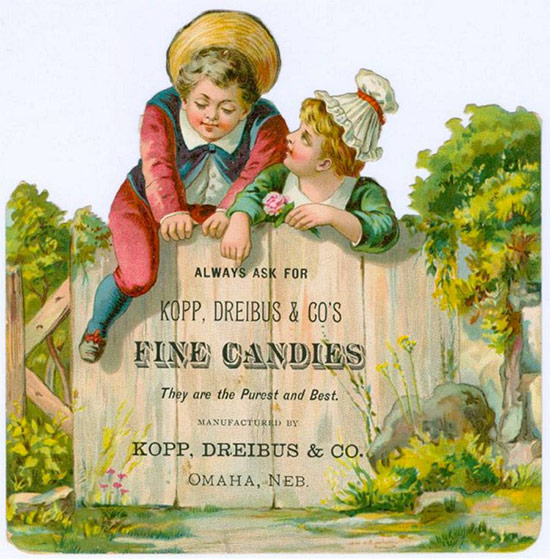
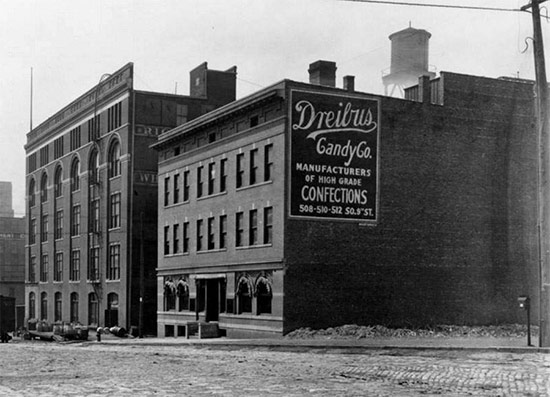
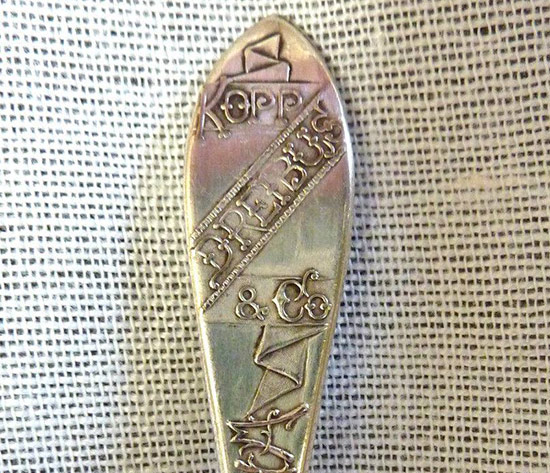
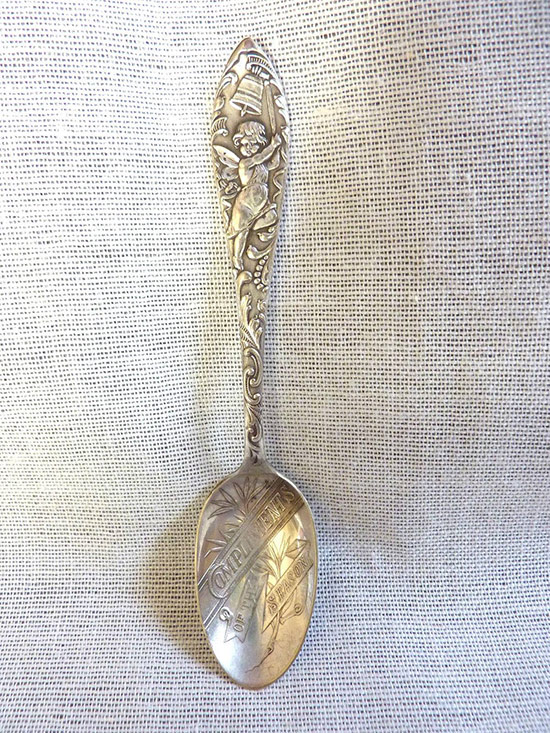
The partnership among the three ended only four years later in 1888, and the Dreibus Candy Co. became a single entity under Anton's control. He employed various family members, including cousin Franz Josef Dreibus, who moved from Germany to work for Anton and ended up creating his own "Dreibus" candy company in Nebraska City (specializing in chocolates.)
Anton's company was the first steam candy company in the state of Nebraska, and he used 1,000 barrels of sugar annually in making his candies. He also developed a strong marketing campaign for the company, employing 10 traveling salesmen and developing various commemorative products to give away.
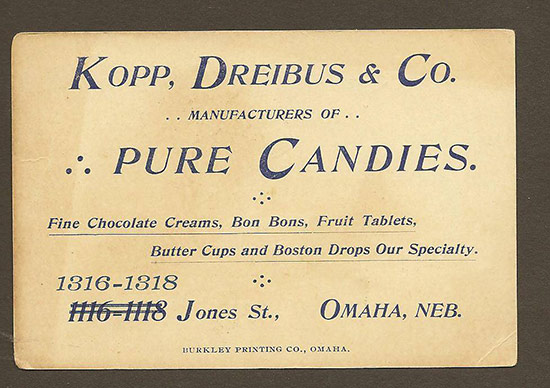
At some point, Northwood produced a carnival glass piece for Anton's company to promote its "Parfait Sweets" line of candies, eight of which are seen here. The pieces came as 6" bowls, plates, and handgrip (with one or two sides up, with the two sides up known as a card tray) plates. They were all in some variation of amethyst (including lavender and horehound.)
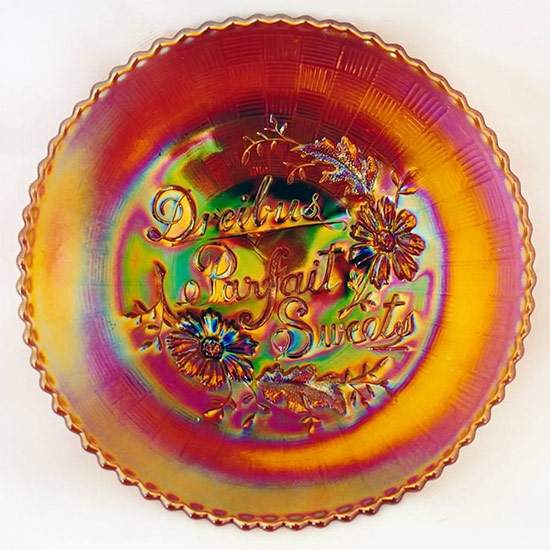
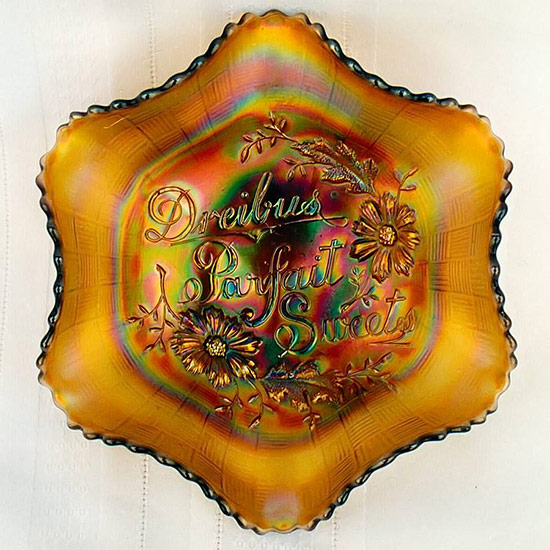
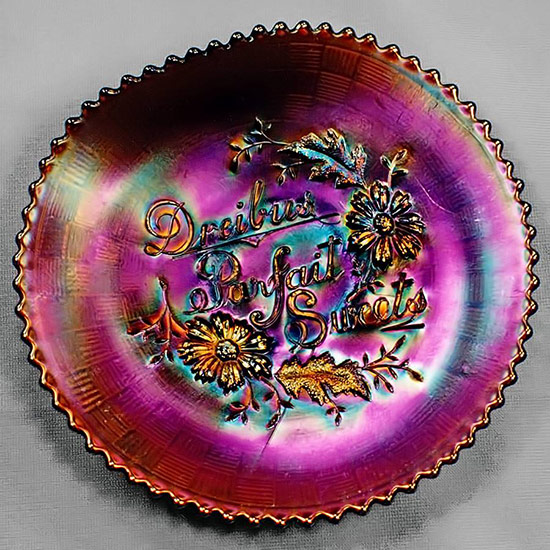
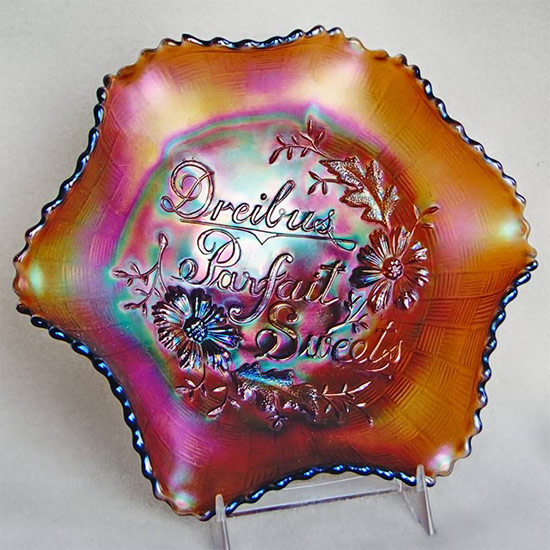
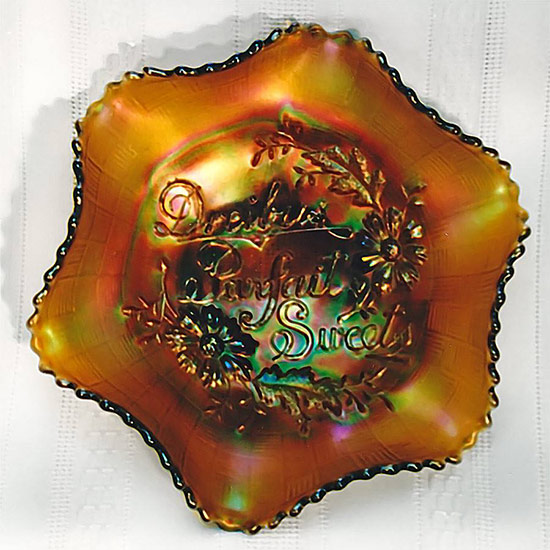
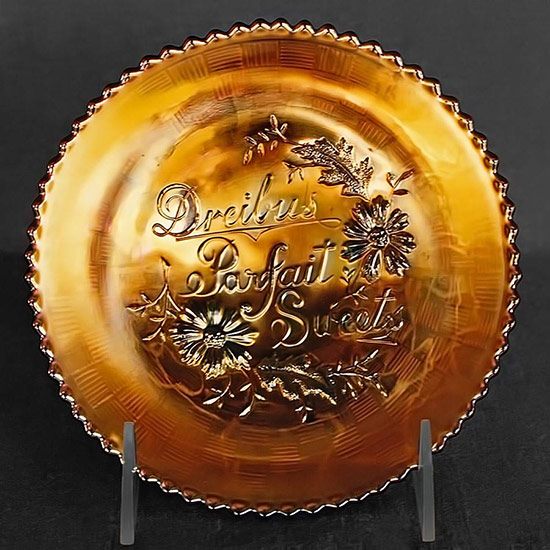
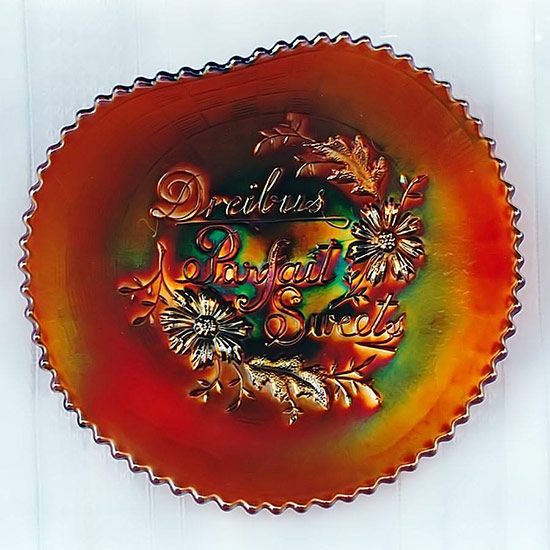
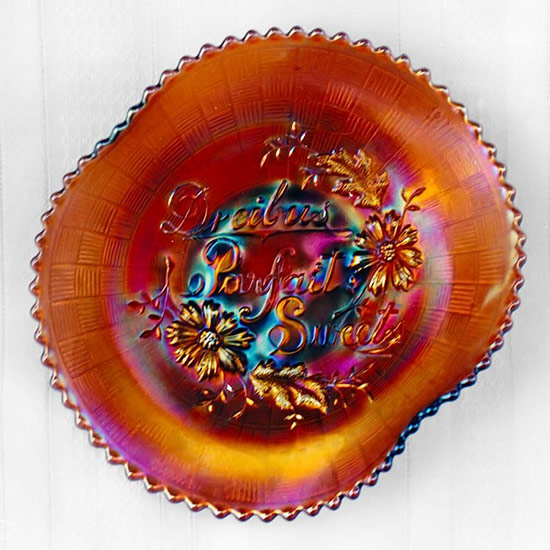
The company continued to grow until the Great Depression hit. By the beginning of the 1930s, the company was in trouble and by the end of the 30s, it was gone. Anton died on October 23, 1937 in Omaha.
The Durham Museum in Omaha named the Dreibus Candy Co. to its Omaha Business Hall of Fame in 2009 and showed various items from the company in that year.
So, did these entrepreneurs using carnival glass to market their brand to consumers work? It's impossible to say, but we can say that many people these days know their names, and for a century after the marketing efforts were launched, that's saying something.
By Brian K. Pitman - 2015
Reprinted (with permission) from the November 12th www.cga mailing list.









Should you care to contact the Frys, their email address is:
Search Carnival Glass 101
back to Carnival Glass 101
Our other sites you may enjoy:
Everything you EVER wanted to know about Indiana Glass
Great Reference for Newer Carnival Glass.
Complete Glassware Catalogs Available to Download
Questions? Comments? Suggestions? Broken Links? Corrections?
Your Friendly Webmaster is here to help!
